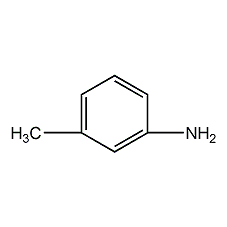
Structural formula
| Business number | 02X6 |
|---|---|
| Molecular formula | C7H9N |
| Molecular weight | 107.15 |
| label |
3-methylaniline, 3-Methylanine, 3-Aminotoluene, Solvent for polyester resin, additive, Metal preservatives |
Numbering system
CAS number:108-44-1
MDL number:MFCD00007808
EINECS number:203-583-1
RTECS number:XU2800000
BRN number:635944
PubChem number:24869600
Physical property data
1. Properties: colorless oily viscous liquid [1]
2. Melting point (℃): -31.5~-30[2]
3. Boiling point (℃): 203.3[3]
4. Relative density (water=1) : 0.999[4]
5. Relative vapor density (air=1): 3.9[5]
6. Saturated vapor pressure (kPa): 0.13 (41℃)[6]
7. Heat of combustion (kJ/mol): -4035.0[7]
8. Critical pressure (MPa): 4.15[8]
9. Octanol/water partition coefficient: 1.40[9]
10. Flash point (℃): 86 (CC) [10]
11. Ignition temperature (℃): 481.67 [11]
12. Explosion upper limit (%): 6.6[12]
13. Explosion lower limit (%) : 1.1[13]
14. Solubility: used as an intermediate in the manufacture of vat dyes. [14]
15. Viscosity (mPa·s, 15ºC): 4.418
16. Viscosity (mPa·s, 30ºC): 2.741
17. Heat of evaporation (KJ/kg): 418.6
18. Heat of fusion (KJ/kg): 66.1
19. Heat of generation (KJ/mol) : 1.36
20. Heat of combustion (KJ/mol, constant pressure): 4042.8
21. Heat of combustion (KJ/mol, constant volume): 4038.6
22. Specific heat capacity (KJ/(kg·K), 29.5ºC, constant pressure): 2.03
23. Thermal conductivity (W/(m·K), 20ºC): 0.1605
24. Vapor pressure (kPa, 41ºC): 0.13
25. Volume expansion coefficient (K-1, 0~30ºC): 0.000820
Toxicological data
1. Skin/eye irritation
Standard Draize test: rabbit, skin contact: 500mg/24H, severity of reaction: mild.
Standard Draize test: Rabbit, eye contact: 20mg/24H, severity of reaction: moderate.
2. Acute toxicity: rat oral LD50: 450mg/kg; mouse oral LD50: 740mg/kg; mouse abdominal LD50: 116mg/kg; rabbit oral LD50: 750mg/kg ; Oral LD50 of wild birds: 242mg/kg;
3. Other multiple dose toxicity: Oral TDLo of rats: 8400mg/kg/30D-I;
4. Toxic The physiological effects are similar to those of o-toluidine. The LD50 of rat transplantation is about 150mg/kg. TJ 36-79 stipulates that the maximum allowable concentration in workshop air is 5mg/m3.
5. Acute toxicity[15]
LD50: 450mg/kg (rat Oral); 3250mg/kg (rabbit transdermal)
6. Irritation[16]
Rabbit transdermal: 500mg (24h), mild stimulation.
The House Rabbit BookEye: 20mg (24h), moderate irritation.
Ecological data
1. This substance may be harmful to the environment. It is recommended not to let it enter the environment.
2. Ecotoxicity[17] EC50: 0.6mg/L (48h) (Daphnia)
3. Biodegradability No data yet
4. Non-biodegradability[18] In the air, when the concentration of hydroxyl radicals is 5.00×105/cm3, the degradation half-life is 2h (theoretical).
Molecular structure data
1. Molar refractive index: 35.31
2. Molar volume (cm3/mol): 107.9
3. Isotonic specific volume (90.2K ): 270.7
4. Surface tension (dyne/cm): 39.5
5. Polarizability: 13.99
Compute chemical data
1. Reference value for hydrophobic parameter calculation (XlogP): None
2. Number of hydrogen bond donors: 1
3. Number of hydrogen bond acceptors: 1
4. Number of rotatable chemical bonds: 0
5. Number of tautomers: none
6. Topological molecule polar surface area 26
7. Number of heavy atoms: 8
8. Surface charge: 0
9. Complexity: 70.8
10. Number of isotope atoms: 0
11. Determine the number of atomic stereocenters: 0
12. Uncertain number of atomic stereocenters: 0
13. Determine the number of chemical bond stereocenters: 0
14. Number of uncertain chemical bond stereocenters: 0
15. Number of covalent bond units: 1
Properties and stability
1. Chemical properties: m-toluidine is oxidized when exposed to light or in the air, and gradually turns brown. Forms salt with acid. Other properties are the same as aniline.
2. Stability[19] Stable
3. Incompatible substances[20] Acids, acid chlorides, acid anhydrides, chloroform, strong oxidants
4. Conditions to avoid contact[21] Light
5. Polymerization hazard[22] No polymerization
6. Decomposition products[23 ] Ammonia
Storage method
Storage Precautions[24] Store in a cool, ventilated warehouse. Keep away from fire and heat sources. The packaging must be sealed and must not come into contact with air. They should be stored separately from oxidants, acids, and food chemicals, and avoid mixed storage. Equipped with the appropriate variety and quantity of fire equipment. The storage area should be equipped with emergency release equipment and suitable containment materials.
Synthesis method
Prepared from the reduction of m-nitrotoluene with iron powder.
Refining method: Distill twice, heat with a slight excess of hydrochloric acid to generate hydrochloride, then recrystallize 5 times in ethanol and 3 times in distilled water. Each time, the initially precipitated acid must be removed. Partially discarded. Treat with dilute sodium carbonate solution, and the resulting free m-toluidine is distilled three times under reduced pressure to obtain pure product.
Purpose
1. This product is the intermediate of Reactive Yellow X-R; Cationic Violet 2RL. It is used as a solvent for polyester resin, an additive for polyurethane foam, a preservative for metal, etc. It is also used as a raw material for azo dyes.
2. Used as an intermediate in the manufacture of vat dyes. [25]

 微信扫一扫打赏
微信扫一扫打赏

